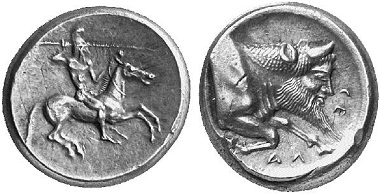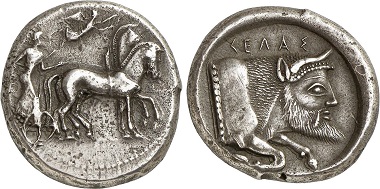translated by Annika Backe
In the early 5th century, entire Sicily focused on Gela and its tyrant Gelon. Here you may gain insight into the coinage of this city in this era.
Gela. Didrachm, 490/85-478/77. Rider. Rv. protome of a river deity r. Ex Künker Auction 94 (2004), 268.
The cavalry of Gelon
Gela started to mint coins under Gelon around 490 BC, perhaps even under his predecessor Hippocrates. Gelon had made it his priority to strengthen the capability of his cavalry. This was perhaps the reason why he chose the rider as a subject for his first coins. And perhaps the substantial hiring of mercenary soldiers was one of the aspects that made him introduce his own coinage.
On the reverse we see the river deity of Gela. His depiction heavily relies on the iconography that was developed for the river god Achelaos and adopted for several coins. Heracles had fought against this river god; while fighting, Achelaos turned into different animals: in a snake, a fish, and eventually a bull. The greatest Greek river of all, he was THE river deity with whom the Greeks associated all the experiences they made with water. It is hardly surprising, therefore, that they borrowed his iconography for their own river deities as well. The river god of Gela is shown with a human face, a long beard, and the horns and ears of a bull. He also has the body of a bull. Sometimes, he is depicted with markedly bent legs which was interpreted as some kind of swimming but is more likely to be the Archaic “Knielaufschema”, as a means of expressing “being in motion”.
Gela. Tetradrachm, 480/75-475/70. Quadriga r., Nike flying from left to crown the horses. Rv. protome of a river deity r. Ex Gorny & Mosch Auction 224 (2014), 48.
Gelon’s complex order of succession
Gelon tried to protect the powerful position of his under-age offspring by dividing the authorities among his brothers. Hieron was given the control over the city of Syracuse. Polyzalos should become tutor of his under-age children and marry the widow of Gelon, Demarete. In addition, he was granted the rule over the city of Gela. It seems justified to connect the introduction of the new coin type in Gela on the obverse, the Syracusan quadriga, with his accession to power. The identical obverse depictions ought to hint at the dynastic relationship between the two cities.
But this will be the subject matter of the next issue of our Sicilian Mosaic.
The article was originally published in MünzenRevue 3/1997.
All parts of the series can be found in our archive.
If you are interested in Sicily, be sure not to miss the numismatic travel diary “Sicily in full bloom”! The whole series can also be found in our archive.







